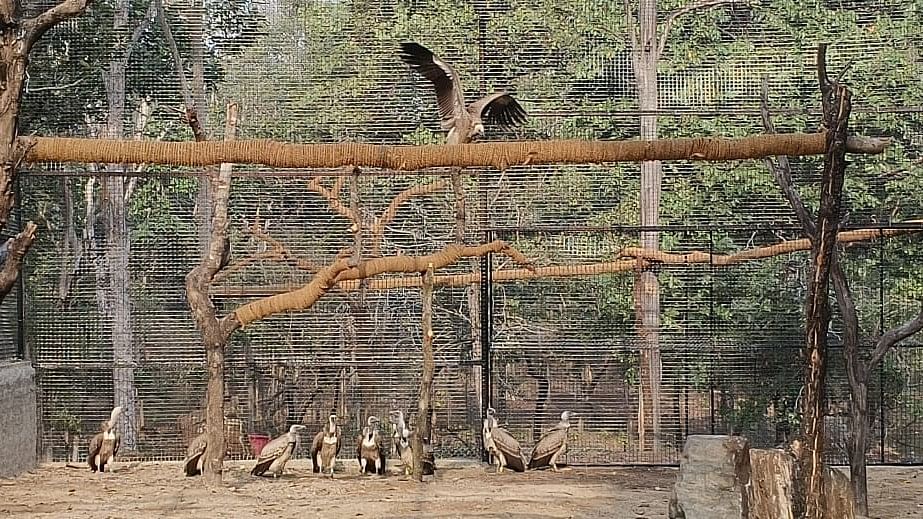
As many as 20 vultures, which were brought from Vulture Conservation Breeding Centre (VCBC) in Pinjore in Haryana, were released in Pench and Tadoba tiger reserves in the Vidarbha region of Maharashtra
Credit: MFD/BNHS
Mumbai: Coinciding with the ‘pran-pratishtha’ of Ram Lalla in the grand temple in Ayodhya, Jatayu (vultures) have found new homes in the Central India Landscape (CIL).
As many as 20 vultures, which were brought from Vulture Conservation Breeding Centre (VCBC) in Pinjore in Haryana, were released in the pre-release aviaries in Pench and Tadoba tiger reserves in the Vidarbha region of Maharashtra - as part of a initiative which was overseen by state Forest Minister Sudhir Mungantiwar.
Credit: MFD/BNHS
The Aranya Kanda (The Forest Episode) of the Ramayan mentions that Jatayu is the "King of Vultures'' (gṛdhrarāja) - who played the heroic role of trying to prevent the abduction of Sita Mata by demon king Ravan. Later, it is Jatayu who narrates to Lord Ram and Laxman about what had happened.
Even in Ayodhya, a bronze idol of Jatayu has been installed in Kuber Tila.
In Nashik, which is closely associated with Ramayan as Lord Ram had stayed here during exile, there is a Sarv Tirth Jatayu Mandir in Taked Budruk in Igatpuri.
Due to the Non-steroidal Anti-inflammatory Drugs (NSAID) drug Diclofenac used in domestic cattle, the vultures that were commonly seen near human settlements have now disappeared. Since carcasses of dead cattle are the main food of vultures, the number of vultures that depend on these domestic animals has declined rapidly.
The long-billed vultures, white-backed vultures and slender-billed vultures were included in the Critically Endangered list of IUCN.
It is estimated that there were 40 million vultures in the skies of India before their numbers plummeted to an estimated 50,000 birds in the 1990s. This sharp decline is due to the use of veterinary pain killer drug Diclofenac, Aceclofenac and Ketoprofen which has proven to be toxic to the vultures.
Conservationists are hoping that their efforts will soon result into presence of Jatayu in our tiger reserves!
The 20 vultures were released by the Maharashtra Forest Department (MFD) and the Mumbai-headquartered Bombay Natural History Society (BNHS), which is spearheading the Jatayu project.
The BNHS and Royal Society for Protection of Birds (RSPB) have been managing four Vulture Conservation Breeding Centres (VCBC) across the country in partnership with the Governments of Haryana in Pinjore (2001), West Bengal in Rajabhatkhawa (2005), Assam in Rani, Guwahati (2007), and Madhya Pradesh in Bhopal (2011).
“At these centres, BNHS scientists have bred more than 750 birds in captivity since 2004, contributing greatly to secure the future of vultures in India,” said BNHS Director Kishor Rithe.
On Sunday, 10 White-rumped vultures were kept under the care of the researchers in the pre-release aviary created in the Botezari area of Kolsa range of Tadoba-Andhari Tiger Reserve while 10 Long-billed vultures released in the pre-release aviary set up in East Pench range in Pench Tiger Reserve.
These vultures will be kept in the aviary for around 3 months to acclimatize with the local condition and to allow them to naturally meet the wild vultures and then released into their natural habitat.
Credit: MFD/BNHS
In Pench, 10 long-billed vultures were released in the aviaries Pench Tiger Reserve under the guidance of Dr Prabhu Nath Shukla, Field Director, PTR and Pooja Limbgaonkar, Assistant Conservator of Forests. This release process was executed by Vivek Rajurkar, Range Forest Officer, East Pench Piparia, Manan Singh Mahadev, Biologist, BNHS, Dr. Sujith Kolangath, Senior Veterinary Officer, Gorewada Rescue Centre, Nagpur.
In Tadoba, Mungantiwar - who encouraged the MFD for the Jataytu project - himself released the birds.
Credit: MFD/BNHS
The event was attended by Praveen Pardeshi, President, BNHS and CEO of Maharashtra Institution for Transformation (MITRA), Shailesh Tembhurnikar , Principal Chief Conservator of Forests (Head of Forest Force), Maharashtra State, Mahip Gupta, Principal Chief Conservator of Forests (Wildlife) and Kishor Rithe, Director, BNHS and Dr Jitendra Ramgaonkar, Conservator of Forests and Field Director, Tadoba-Andhari Tiger Reserve. Nandkishore Kale, Deputy Director, (Core), Sachin Shinde, Divisional Forest Officer, Tadoba-Andhari Tiger Reserve; while Forest Range Officers, Rundan Katkar, Arun Gond, Vinod Jambhule and the field staff of the forest department, played an important role.